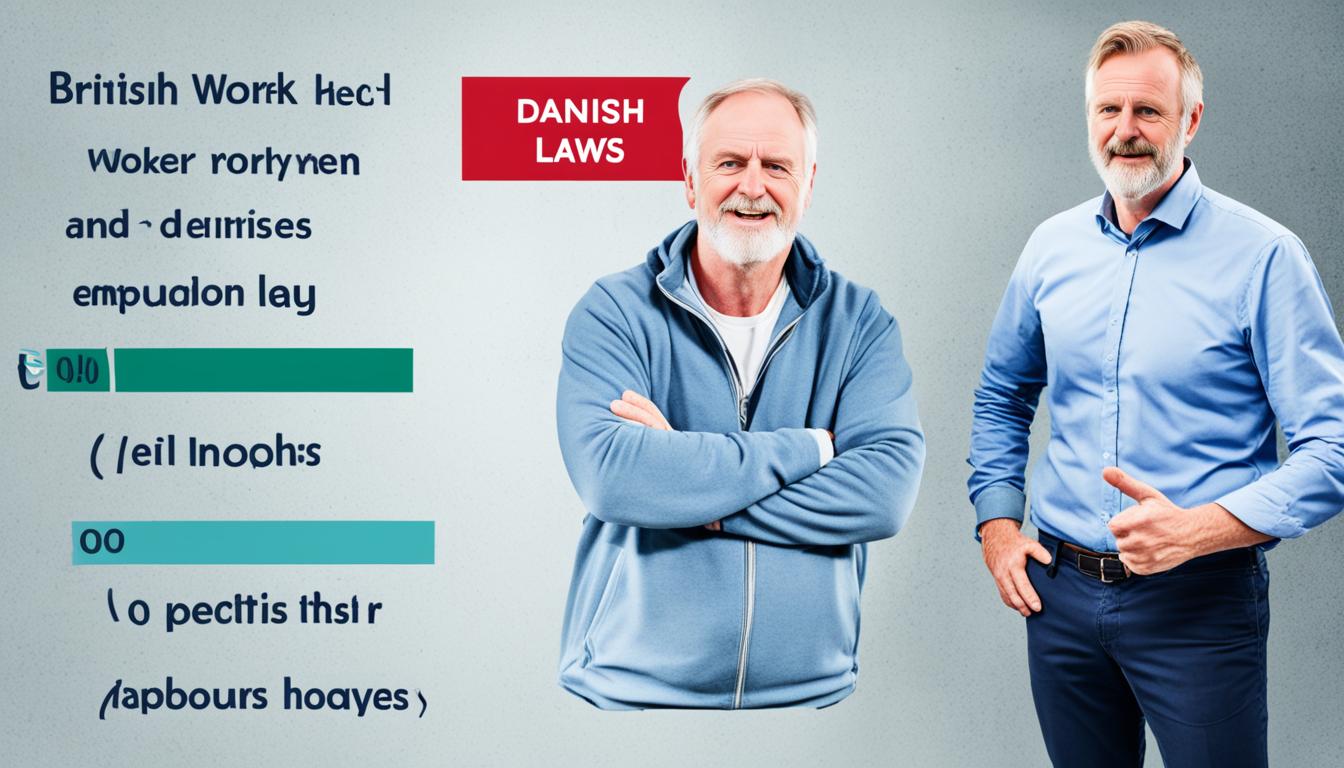UK Labour Laws: What Can We Learn from Denmark
What if we could improve UK labour laws by taking cues from Denmark? Looking at Denmark’s employment practices, we wonder: could their approach boost our workforce’s well-being? Let’s explore how Denmark’s system might enhance employee rights and work-life balance in the UK.
We’ll look at the similarities and differences in labour laws between the UK and Denmark. We aim to find elements that could lead to positive changes in our practices. By sharing these insights, we hope to create a better work environment for all.
Key Takeaways
- Understanding the strengths of Denmark’s employment regulations.
- Exploring work-life balance benefits for employees in the UK.
- Comparative analysis of employee rights in both countries.
- The importance of cooperative labour market practices.
- Insights into flexible workplace policies.
Overview of UK Labour Laws
UK Labour Laws are key to understanding how employers and employees interact in various sectors. The Employment Rights Act 1996 is a major law that gives employees important rights. It ensures they are treated fairly at work. This includes protection against unfair dismissal and how to end employment contracts.
The Working Time Regulations 1998 set rules for Working Hours. They limit how much time people can work each week and ensure they get rest breaks. These rules help balance work and life, supporting employee well-being. They also cover Paid Leave, giving workers a minimum of 5.6 weeks off each year to rest and enjoy life outside work.
The National Minimum Wage Act sets the lowest pay employers can offer. This ensures workers get fair pay for their work. Looking at these laws shows they protect employees’ rights but also highlight areas that could be improved. By studying these rules, we can find ways to make work better for everyone.
Understanding Danish Employment Regulations
The Danish labour market is unique, mainly because of collective agreements that set work rules. These agreements are more important than strict laws, making work life flexible for everyone. In Denmark, unions and employers work together to make these agreements, balancing job security and flexibility.

This way of working builds trust and openness in the workplace. Workers get strong protection against unfair job losses and other risks. The idea of flexicurity is key in Denmark, mixing job flexibility with job security in benefits. This means workers can easily move between jobs, knowing they have support if they lose their job.
Looking closer at Denmark’s labour market shows us some good points for other countries to think about. We can see what makes workers happy and productive in such a system.
| Aspect | Danish Employment Regulations | UK Employment Regulations |
|---|---|---|
| Governing Framework | Collective Agreements | Statutory Legislation |
| Trade Union Influence | Strong Collaboration | Variable Strength |
| Job Flexibility | High | Moderate |
| Employee Security | Unemployment Benefits | Welfare Support |
This comparison shows us how the Danish and UK systems are different. It makes us think about how the UK could change.
UK Labour Laws: What Can We Learn from Denmark
Looking at UK Labour Laws, we see Denmark has much to teach us. They focus on laws that protect workers and support a good work-life balance. This leads to happier workers and better productivity.
Denmark values employee rights a lot. They have strict rules about working hours, holidays, and working conditions. The UK could learn from this by giving workers more protection and support. This would make the workplace better for everyone.
Flexibility is another key lesson from Denmark. They have rules that let workers negotiate their jobs better. The UK could look into making work conditions more flexible, not just strict contracts.
To show what Denmark and the UK are like, let’s compare some key points:
| Factor | Denmark | UK |
|---|---|---|
| Working Hours | Average 37 hours per week | Average 40 hours per week |
| Parental Leave | Flexible paid leave for both parents | Statutory maternity leave, limited paternity leave |
| Paid Vacation | Minimum 5 weeks per year | Minimum 5.6 weeks per year |
These comparisons show that the UK could learn a lot from Denmark’s Labour Laws. By adopting some of Denmark’s strategies, we could make work better for everyone.
Work-Life Balance in Denmark
Denmark is known for its strong focus on Work-Life Balance. The 37-Hour Workweek is a key part of this. It shows that work should be productive but also allow time for personal happiness.
Importance of a 37-Hour Workweek
In Denmark, the 37-Hour Workweek helps everyone work more efficiently. Workers aim to do their best during these hours. This way, they can also enjoy their free time, leading to a balanced life.
This approach boosts productivity now and helps with long-term well-being.
Impact of Paid Vacation on Employee Well-being
Five weeks of paid vacation are a big part of Denmark’s Work-Life Balance. This policy is key for workers’ health. Taking breaks helps people come back to work refreshed and ready to do their best.
This focus on well-being makes the workplace better for everyone. It shows that caring for employees makes the whole team more motivated and productive.

Flexibility in Danish Workplace Policies
Danish workplaces are known for their flexibility, benefiting both employees and employers. This flexibility is seen in collective agreements and individual contracts. These are key in shaping the work environment. They show how Denmark’s labour market values cooperation.
Collective Agreements vs Individual Contracts
In Denmark, collective agreements are vital for setting workplace policies. These are made between trade unions and employers. They ensure workers get fair pay, reasonable hours, and good benefits.
Collective agreements bring workers together, offering a safety net for their interests. This leads to happier workers and less job turnover. Employers also gain from a happy workforce, seeing better productivity and fewer staff leaving.
Parental Leave and Family Support
Denmark shows its support for families with generous parental leave policies. Both parents get a lot of leave after a child is born. This helps families spend quality time together and supports gender equality by sharing childcare duties.
This flexible leave lets families choose what’s best for them. Danish employers support these policies, knowing they help the company too. The UK could learn from Denmark to support working families better, making workplaces more inclusive.

Employee Rights in Denmark: A Comparison
In our quest for a Comparative Analysis, Denmark stands out when compared to the UK. Danish law gives employees strong protections. This lets us see where the UK might improve.
Denmark ensures workplaces are safe and healthy for everyone. The UK also has health and safety laws, but there are still gaps. This shows we need a strong system that helps employees stay safe and follow the rules.
Denmark has strong laws against discrimination. This makes the workplace welcoming for everyone. The UK also has laws, but discrimination still happens. So, we need to work harder to protect everyone’s rights.
Denmark supports disabled workers well, showing a strong commitment to inclusion. There are many resources and programs to help disabled people find jobs. The UK could learn from this, improving support to make sure everyone has equal chances.
| Aspect | Denmark | UK |
|---|---|---|
| Health and Safety Regulations | Comprehensive and rigorously enforced | Established but with notable enforcement gaps |
| Anti-Discrimination Laws | Strong protections promoting inclusivity | Present but often inadequately enforced |
| Support for Disabled Workers | Extensive resources and inclusive programmes | Limited tailored support |

The Concept of Flexicurity in Denmark
The Danish labour market shows a new way called flexicurity. It links job security with the chance to change jobs. Workers feel safe in their jobs but can also explore different careers. This approach could help the UK create a strong workforce.
Balancing Flexibility and Job Security
Flexicurity mixes job security with the chance to change jobs. Danish policies help workers move between jobs easily. This lets them try out different roles and industries.
- Supportive training programmes give workers the skills for various jobs.
- Pension schemes and social security protect workers when they’re jobless.
- Shortened periods for unemployment benefits push workers to find new jobs faster.
This mix makes a lively job market where workers feel secure, even when things change. Using parts of this idea could help the UK make jobs more secure and flexible.

Vacations and Time Off: Lessons for the UK
In Denmark, the way people view vacations and time off has a big impact on their work culture. They have a law that says everyone must get five weeks of paid holiday. This helps keep a good balance between work and personal life.
This shows that in Denmark, taking holidays is seen as a right, not just a privilege. It’s a key part of staying mentally healthy and productive at work. When people feel free to enjoy their holidays, they come back more engaged and motivated.
For the UK, learning from Denmark about how to handle vacations could bring big changes. By valuing time off, UK businesses might make their workers happier. This could lead to more productivity and fewer cases of burnout.
Looking ahead, we must stress the importance of holidays at work. By making vacations a priority, companies can create a better work environment. This benefits both employees and employers in the long run.
Benefits of a Cooperative Labour Market
A cooperative labour market is key to a strong economy, like Denmark shows us. When trade unions, employers, and the government work together, they do more than just follow rules. This partnership creates a fair and balanced workplace.
This approach has many benefits. For one, happy employees work better. When Employee Engagement is a priority, everyone’s morale goes up. People feel important and are more likely to give their all at work.
This leads to more productivity and innovation. Employees are eager to share their ideas when they feel valued.
Also, a cooperative labour market makes jobs more secure and satisfying. When everyone works together, sudden job changes or insecurity are less likely. This makes workers loyal, helping companies keep their best people.
Let’s look at some key points in a table:
| Aspect | Cooperative Labour Market (Denmark) | Traditional Labour Market (UK) |
|---|---|---|
| Employee Engagement | High levels of participation in decision-making | Limited engagement in strategic decisions |
| Job Security | Stable employment with strong support systems | Varying levels of job security with higher turnover |
| Innovation | Encouraged through collective problem-solving | Often stifled by hierarchical structures |
| Work-Life Balance | Prioritised with generous leave policies | Less emphasis on balance, leading to burnout |
Looking at the UK’s Labour Relations, adopting the cooperative model could change things for the better. It could lead to a happier and more productive workforce. This shows why changing our approach could be a smart move for the future.
Conclusion
Looking at UK Labour Laws and the Danish Employment Model, we see how they can help us improve our rules. The Danish model is great at balancing work and life. It has a 37-hour workweek and lots of paid holiday, which makes workers happier.
They also have flexible work policies and good parental leave. This helps employees manage work and family life better. It makes for a positive work environment and happy workers.
When we think about these ideas, it’s clear that the UK could benefit a lot. By taking cues from Denmark, we can push for changes that help workers. This could make work better for everyone in the UK and make our country more productive.






